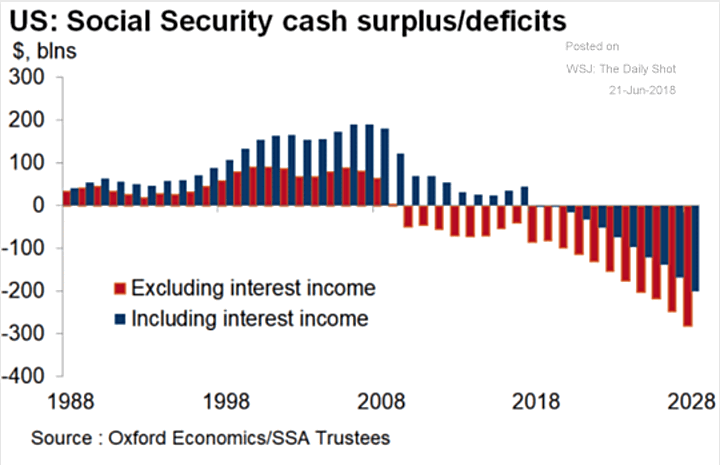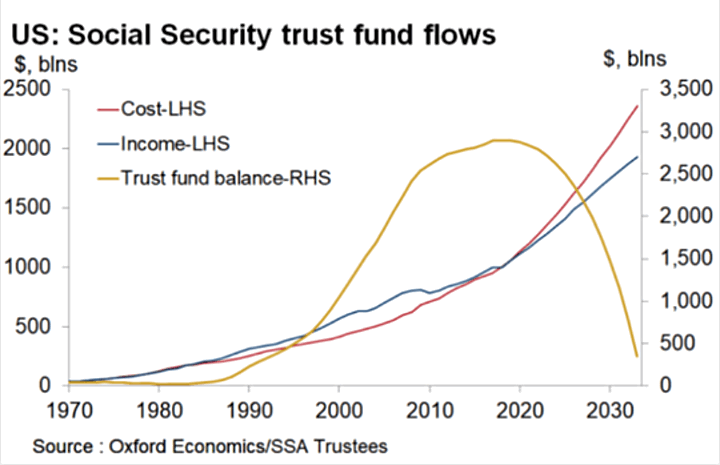 You may have read recently that the Social Security Trust Fund is starting to shrink, and that it is projected to run out of money in 16 years. (Medicare’s trust fund is projected to run out in 8.) This is not the same thing as Social Security itself running out of money, as most Social Security payments to retirees come from the payroll taxes paid by current workers. As the NY Times points out:
You may have read recently that the Social Security Trust Fund is starting to shrink, and that it is projected to run out of money in 16 years. (Medicare’s trust fund is projected to run out in 8.) This is not the same thing as Social Security itself running out of money, as most Social Security payments to retirees come from the payroll taxes paid by current workers. As the NY Times points out:
…tax collections would be sufficient to pay about three-fourths of promised Social Security benefits for 75 years.
Of course, a 25% cut is still going to be extremely painful for a lot of people. However, I don’t expect any changes soon. As the WSJ Daily Shot points out, Social Security has had a cash deficit each year since 2009. (More was being paid out in benefits than was taken in by payroll taxes.) The deficit was simply masked by interest earned on the fund until recently:

“Fixing” this problem is going to hurt somebody in the pocketbook – either younger workers or retirees, probably both. That means no politician is going to do anything about it unless there is no other option. The following chart of income vs. expenses suggests that about 2030, the trust fund will be nearly depleted and the rate of depletion will be quite fast.

So that’s my prediction. All talk and no action until 2030.
 The Best Credit Card Bonus Offers – November 2024
The Best Credit Card Bonus Offers – November 2024 Big List of Free Stocks from Brokerage Apps
Big List of Free Stocks from Brokerage Apps Best Interest Rates on Cash - November 2024
Best Interest Rates on Cash - November 2024 Free Credit Scores x 3 + Free Credit Monitoring
Free Credit Scores x 3 + Free Credit Monitoring Best No Fee 0% APR Balance Transfer Offers
Best No Fee 0% APR Balance Transfer Offers Little-Known Cellular Data Plans That Can Save Big Money
Little-Known Cellular Data Plans That Can Save Big Money How To Haggle Your Cable or Direct TV Bill
How To Haggle Your Cable or Direct TV Bill Big List of Free Consumer Data Reports (Credit, Rent, Work)
Big List of Free Consumer Data Reports (Credit, Rent, Work)
Maybe the first step to resolving the short fall should be to arrest the entire US Congress, seize their assets and the assets of all US government employees and pay back the $5Trillion they stole from Social Security Trust based on a memo written by some worm at the DOJ and The Dept of 1984 Newspeak which said ” The Social Security TRUST is not a trust.
Maybe the first step is to Privatize Social Security the right way and take it out of DIRECT Congress control; indirect involvement id ok. There has never been money in the trust fund and contrary to belief, the money had never really been invested. Yes it does buy Government Bonds but bonds are just a loan with a promise to pay; not a true investment that will actually grow.
This is what I see online and to be honest I wish I understood it better because other then lie, kill and incarcerate the government rarely does anything well other then steal. As I understand it the government bonds held by SSA are unique in that they contain a clause that says the government has no obligation to actual repay them. Who would buy or hold a bond like that?
The Social Security Administration collects payroll taxes and uses the money collected to pay Old-Age, Survivors, and Disability Insurance benefits by way of trust funds. When the program runs a surplus, the excess funds increase the value of the Trust Fund. At the end of 2014, the Trust Fund contained (or alternatively, was owed) $2.79 trillion, up $25 billion from 2013.[4] The Trust Fund is required by law to be invested in non-marketable securities issued and guaranteed by the “full faith and credit” of the federal government. These securities earn a market rate of interest.[5]
Excess funds are used by the government for non-Social Security purposes, creating the obligations to the Social Security Administration and thus program recipients. However, Congress could cut these obligations by altering the law. Trust Fund obligations are considered “intra-governmental” debt, a component of the “public” or “national” debt. As of June 2015, the intragovernmental debt was $5.1 trillion of the $18.2 trillion national debt